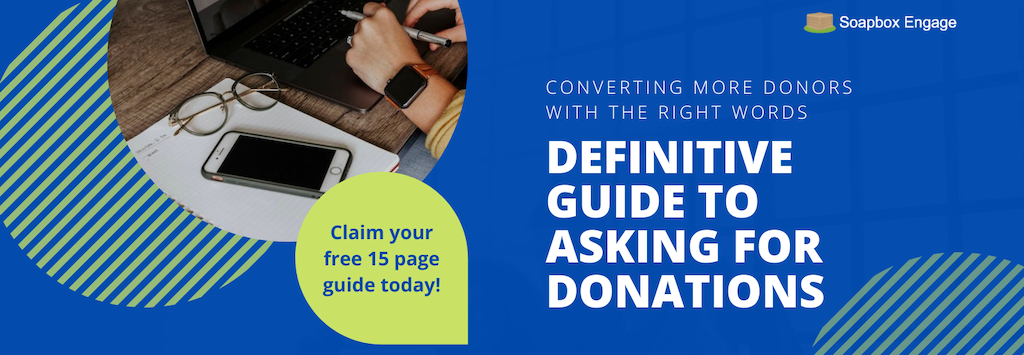
When you plan a new fundraising or marketing campaign, one of the first questions is often: “Who is our audience?”
It’s tempting for the answer to simply be “Well, isn’t it everyone?” And while that may be true on some level, the same approach isn’t effective for every supporter. For instance, you wouldn’t ask a major donor for the same gift as you would a grassroots supporter.
So, what does that mean for your donor communication strategy? For starters, it means donor communications are most effective when tailored to different audiences. More specifically, we recommend segmenting your supporters across four key groups–grassroots supporters, partners and ambassadors, major donors, and board members.
From there, you can edit your communications strategies to engage each supporter group more efficiently. And, in the coming sections, we’ll show you how. Let’s jump in!
Grassroots Supporters
Grassroots supporters tend to be hyperactive, taking on your campaigns with gusto. They’re usually the first ones to watch and share videos. And with every campaign, they give a small donation or offer volunteer hours.
In other words, grassroots supporters are dependable, earnest, and active go-getters who consistently push your initiatives forward.
So how do you communicate with this group of supporters effectively? Here are a few tips:
- Define impact in clear, simple terms. What exactly does a $10 gift go toward for your nonprofit? When will it make a difference? How will it make a difference? Each of these questions should be answered in your email campaigns, storytelling, and other outreach.
- Be in touch–but not too much. These folks want to hear from you, but be careful not to flood their inboxes. With too few points of contact, they’ll wonder if you’re still around and if you’re making any campaign progress. Offer too much contact and they’ll hit that unsubscribe button. Opt for a planned email approach so they can count on when to hear from you.
- Tell a story. While your data and impact measurements should be simple, your storytelling should be nuanced and resonant. Grab their attention with a compelling story, whether in a series of fundraising appeals via email or a video update on your website homepage.
- Thank them often. Best practice reports consistently indicate the same thing: always thank your donors. Start with a donor appreciation email after an online donation. Then, find other creative and personal touches—handwritten notes, personalized video messages, or a phone call.
You can even use tools like digital eCards to send a quick, customized thank you. In fact, eCardwidget provides free templates to make expressing gratitude that much easier. From event attendees to dedicated volunteers, you can use these cards to make your grassroots supporters feel valued for their efforts.
Partners and Ambassadors
Working with brand ambassadors or partner organizations can be challenging but can also reap great rewards. If you’re fortunate enough to work with an organization or an individual with a substantial social media following, take full advantage of the opportunity-—-a single tweet from a big name can garner serious funding in a matter of hours.
Here are some things to keep in mind when communicating with this group of stakeholders:
- Set clear roles. Do you want this partner or ambassador to be a spokesperson? Will they show up at events? What do you want them to ask when communicating with their networks? It’s important to define a relationship that works for everyone.
- Define their impact. If you want an influencer to go on a trip or attend an event with you, explain why their presence is impactful. Or, if you want them to help lead a fundraising campaign and plan using their name, branding, and social media influence, explain how and why you chose this campaign type, and how you will measure success.
- Tell their story. Work with partners and ambassadors who are willing to discuss their personal investment in your cause. For instance, a fitness influencer may be uniquely invested in furthering physical fitness activities for underserved youth based on their own childhood experience.
- Thank them. Of course, sending a personal thank you is great, but it’s important to find other ways to highlight their efforts to your entire community, to the media, and to other stakeholders. Kwala’s guide to donor gifts suggests planning an online gratitude campaign to make ambassadors feel especially valued.
Keep in mind that partners and ambassadors may need additional clear expectations and guidelines. Many nonprofits draft a Memorandum of Understanding (MOU) that outlines what exactly they will provide to you and what you will provide to them. That way, everyone is on the same page concerning the partnership’s goals and objectives.
Major Donors
Major donors fund big solutions for big problems. They may make a large gift of $50,000 or double the size of that gift through a matching gift program.
For investments this large, your relationships and communications should be solid.
Here are some tips to keep in mind:
- Define their purpose. Talk with your donors about how they intend to support your cause and what that support looks like over time. Tell them their options and invite them to discuss their vision. Do they want to make a large one-time gift for an urgent call to action? Do they envision many gifts over the course of several years?
- Determine a feedback loop. Each donor will be different in terms of how much communication they need. Some may want weekly calls or emails; others may only check in once or twice a year, depending on their priorities and interests. Be sure to define the frequency and type of communication early on.
- Manage expectations. Your campaigns are most likely determined by feedback from major donors based on what they can and want to support. Set clear roles in the beginning on how or if major donors can provide input as part of their investment, and keep them engaged and informed along the way.
- Show them a return on investment. Major donors require a bit more than a thank-you email or handwritten note. If your nonprofit does work in international development, that may mean taking people on a trip in the field. Or perhaps it’s connecting them with other key stakeholders through donor appreciation events. Find ways to show appreciation and impact that speak to their level of commitment.
Plan your major donor communications ahead of time to ensure your team does everything it can to express gratitude and offer engagement opportunities for this valuable group.
Board Members
If anyone really has a say in what happens with your organization, internally and externally, it’s often your board. The board can make decisions about your budget, your operations, your leadership and staff, and ultimately, how and what you choose to support. That means the board probably has the most information about your daily ins and outs than anyone else, but they also may stay at the top level once campaigns are live.
To keep board members engaged year-round, implement these best practices:
- Provide personalized opportunities. Board members often moved up the ladder of commitment themselves, from grassroots supporters to this committed leadership position. Use each board member’s previous experience to engage them in key opportunities. For instance, you might ask a newer board member with volunteer experience for tips on how to better your existing program.
- Keep them informed outside the boardroom. Board members want to know what’s going on beyond scheduled meetings. Send out surveys and conduct individual discussions with each member to discuss additional areas of interest. For example, a board member might have some fresh campaign ideas to share, invite them to coffee to discuss them further.
- Don’t assume they are above grassroots-style activism. Board members are still great resources for your grassroots efforts, don’t count them out! Some may have a blog, and many definitely have social media accounts. Find ways that your board members can support you at all levels—not just for high-level operations and major gifts.
Board members want to be involved on the ground, not just during campaign planning and outreach discussions. Invite them to collaborate or reach out to their personal or professional networks for volunteer or peer-to-peer support.
While each of these stakeholder groups is providing different levels of commitment to your cause, there are many things they have in common: they all want clear, defined impact; they expect consistent communication and useful information. Additionally, regardless of their investment level, they all want to be genuinely thanked for their efforts.
